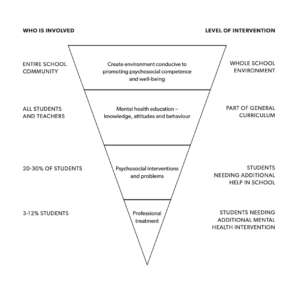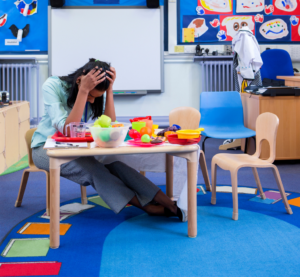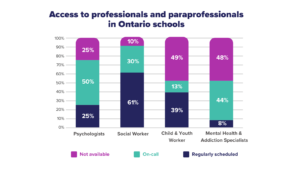Mind and Matter: The Vital Link Between Mental Health and Education
According to the World Health Organization (WHO), mental health disorders will be the world’s leading cause of disability by 2030.
Recent data from Statistics Canada and CAMH back up the WHO warning. According to StatsCan, the percentage of 12 to 17-year-olds who describe their mental health as very good or excellent dropped from 73% in 2019, to 61% in 2022. In their responses to CAMH’s 2023 Ontario Student Drug Use and Health Survey 51% of Ontario students reported a moderate-to-serious level of psychological distress – double the proportion from ten years ago.
But what do we mean when we talk about mental health?
Is it possible to learn how to be mentally healthy, in the same way we learn about, and practice physical health?
If – as multiple studies have shown – the majority of mental health disorders emerge during childhood and adolescence, can we do something to change the mental illness trajectory for many young people?
The short answer is yes.

The role of schools – Why they are integral to promoting mental health
There are key teachable/learnable skills that support mental health. These skills can be taught starting in early childhood and throughout school. They not only promote good mental health but, in many cases, these skills can also help to prevent mental illness. Schools, because they are so integral to the lives of children and youth, are a natural social-emotional learning environment and are the best places for effective promotion and interventions in physical and mental health.
Students can learn social-emotional competencies, such as self-awareness, self-management, social awareness etc., just as they learn formal academic skills. However, teaching these skills requires support for teachers and recognition of their essential importance by integrating them into curriculum. — Learn more about these competencies.
Moreover, researchers and health experts, including the World Health Organization, are united in their view that schools – where children and youth spend much of their time – are the ideal place not just to promote mental health but also to provide support and interventions that can alleviate, or even prevent, many forms of mental illness.
WHO Report 20061
Fig 1: COMPREHENSIVE SCHOOL MENTAL HEALTH

Mental health education and support in schools – The current status
Though there is extensive evidence that schools play a key role and are crucial to promoting mental health among children and youth, data from People for Education’s Annual Ontario School Surveys (AOSS) present a worrisome picture:
In 2023-24:
- Only 25% of schools (23% of elementary and 33% of secondary) strongly agree or agree that they have the resources necessary to support the mental health and well-being of their students, a decline from 42% overall in 2022-23 (40% of elementary and 55% of secondary).
- 25% of schools (24% of elementary and 29% of secondary) do not have access to psychologists either regularly scheduled or on call. Over the last 10 years, the percentage of elementary and secondary schools with NO access to psychologists has doubled.
- 29% of secondary schools and 4% of elementary schools have regularly scheduled access to mental health and addictions specialists; 23% of secondary and 53% of elementary schools have no access at all.
 In 2022-23:
In 2022-23:
- 91% of schools reported needing some or more support for students’ mental health and well-being.
- Only 9% of schools reported they have regularly scheduled access to a mental health/addiction specialist or nurse, and 46%% of schools reported no access at all.
- 28% of elementary and secondary schools reported they have no access to a psychologist, either virtually or in-person; nearly double the percentage with no access in 2011.
- 82% of schools reported needing support staff such as educational assistants, administrators, and custodians.
Source – Annual Ontario School Survey 2023-24
“We keep hearing about the mental health of students; however, where are the supports? There has not been an increase in the number of Child and Youth Workers, or social workers assigned to schools – in some cases, the youth workers are shared between two secondary schools and are not in their schools every day – you can’t build a sense of community and trust with students if you aren’t in the building.”
Secondary school principal, GTA
“We are drowning. I have never seen it like this. Even during covid it was better than now. Everyone is struggling and we don’t know what to do to make it better. A crisis is coming in education.”
Secondary school principal from Central Ontario
The need for more investment
As the connection between mental health and education becomes increasingly evident, it is imperative that schools serve as both academic institutions and hubs for mental health promotion and support. By fostering a culture of well-being and integrating mental health education into daily learning, schools can equip students with the essential skills needed for overall wellbeing and success in life. However, the current gaps in supports for students who are struggling, in resources to support integrating mental health education into curriculum, and in supports for school staff, highlight the urgent need for increased investment and more effective policy to support students’ mental health. Only by addressing these challenges can we ensure that all students are given the opportunity to thrive both mentally and academically, laying the foundation for a healthier, more resilient future generation.
“Ongoing staffing challenges, lack of daily staff supports for post-pandemic recovery, daily bus cancellations, lack of system navigation and social work for all families, and a focus on ‘catching up’ when massive structural issues continue to be major challenges. The idea that we are ‘back to normal’ seems to reign, yet every day is a challenge for staff and families. This places incredible pressure on administrators and staff who consistently attend work, further burning out essential staff. With labour challenges at the forefront and possible strikes, it remains unseen how much more the system can bear.”
Elementary school principal, Northern Ontario
People for Education’s recommendations from 2022-23 are valid in 2024 too. Read them here.

